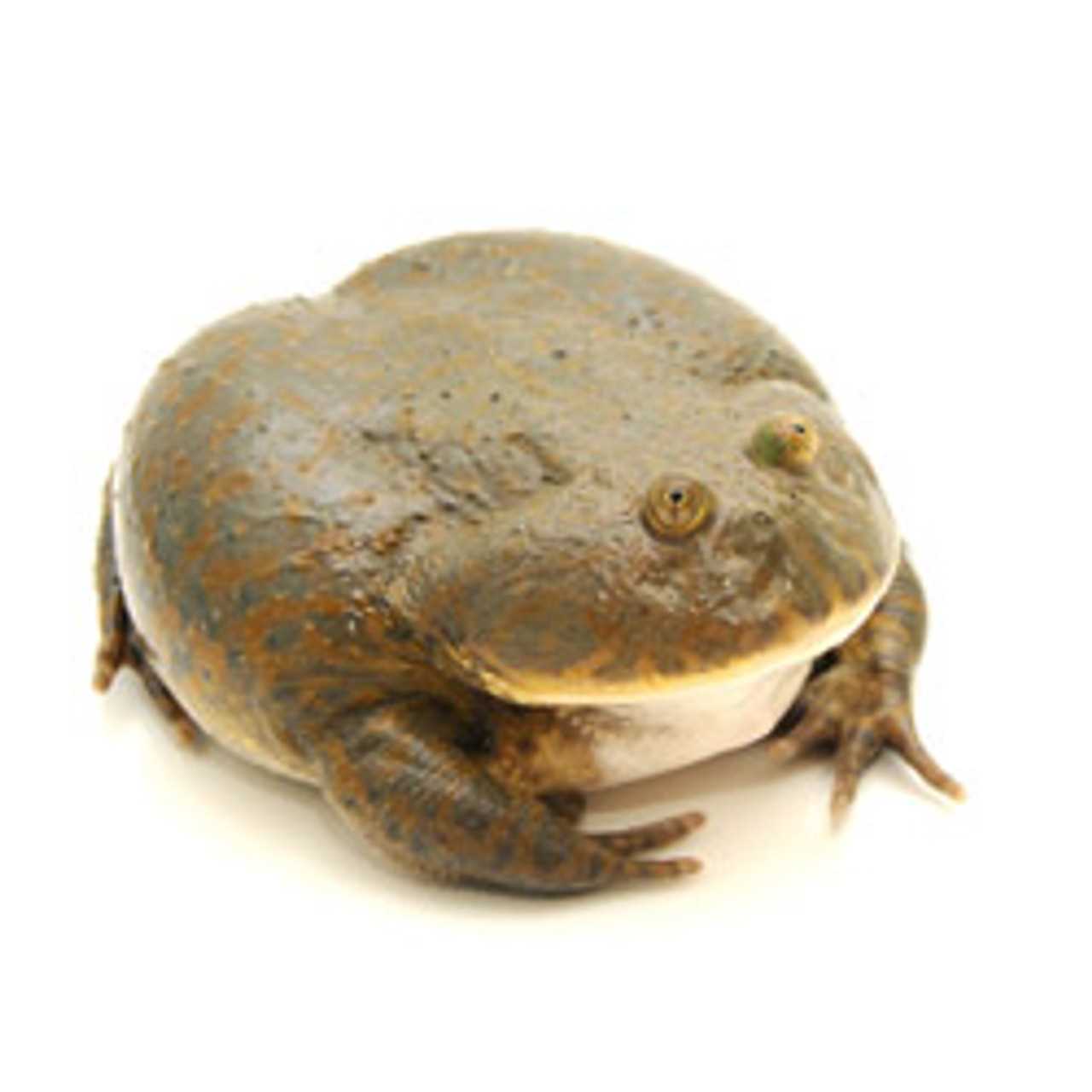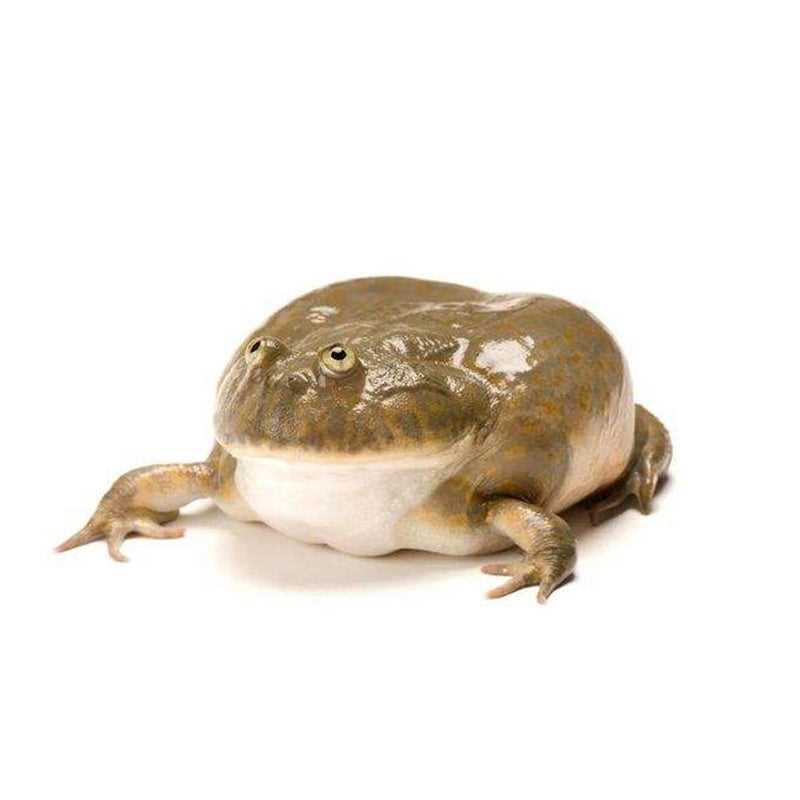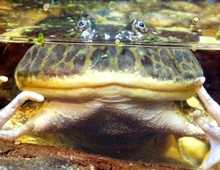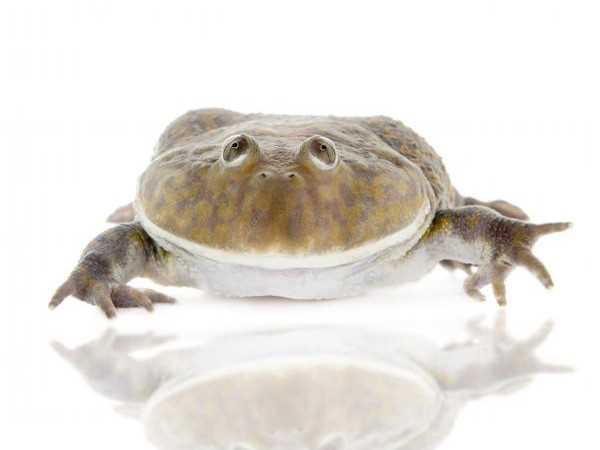
One of the most striking features of Budgett frogs is their distinctive appearance. They have a flat, round body with a large mouth and bulging eyes. Their skin is covered in bumpy, rough texture, which gives them an intimidating look. Budgett frogs are typically olive green or brown in color, allowing them to blend in with their natural environment.
Another interesting characteristic of these carnivorous frogs is the amplexus behavior they display during mating season. During amplexus, the male frog grasps the female from behind and fertilizes her eggs as she lays them. This unique breeding behavior is quite fascinating to observe and adds to the appeal of owning Budgett frogs.
Caring for Budgett Frogs: A Complete Guide
Choosing the Right Terrarium
The first step in caring for Budgett Frogs is to provide them with a suitable terrarium. These frogs are semi-aquatic, which means they require both land and water. A terrarium with ample space for swimming and a land area for them to rest is essential. It is recommended to use a glass terrarium with a secure lid to prevent escape.
Ensure that the water area in the terrarium is large enough for the frogs to fully submerge. The water should be clean and chlorine-free. It is best to use dechlorinated water or aged tap water. Additionally, provide hiding spots in the form of rocks, logs, or plants for the frogs to feel secure.
Providing the Right Environment
Budgett Frogs are native to the wetlands of Brazil and require a warm and humid environment. Maintain a temperature of around 75-85°F (24-29°C) during the day and a slight drop at night. To achieve the required humidity level of 50-70%, mist the terrarium with water daily. You can also use a hygrometer to monitor the humidity levels.
Feeding the Budgett Frogs
Budgett Frogs are carnivorous and feed primarily on live prey. They enjoy a diet of insects, worms, and small fish. Offer a variety of food to ensure a balanced diet. Dust the prey with a calcium supplement before feeding to ensure the frogs are getting the necessary nutrients.
It is essential to feed the frogs the appropriate size of prey. Avoid feeding them anything too large that may cause choking or difficulties in digestion. Additionally, remove any uneaten prey from the terrarium to maintain cleanliness.
Mating and Reproduction
One interesting behavior of Budgett Frogs is amplexus, which is the mating process where the male grips the female to fertilize the eggs externally. If you plan on breeding these frogs, ensure that the terrarium has a suitable area for the female to lay her eggs. Provide a shallow water area with floating plants or a spawning mop for the eggs to be laid on.
It is recommended to separate the female from the male after mating to prevent any aggression or stress. The eggs will hatch into tadpoles, which will require their own separate setup for proper development.
Health Concerns

As with any pet, Budgett Frogs can develop health issues. Keep an eye out for signs of illness such as loss of appetite, lethargy, or abnormal behavior. Regularly clean the terrarium to prevent the buildup of bacteria and parasites.
Characteristics of Budgett Frogs: What You Need to Know
One of the most striking characteristics of budgett frogs is their appearance. They have a stout and robust body, similar to that of a toad, which sets them apart from the more slender and streamlined frogs. They have a large triangular head with bulging eyes on either side. Their skin is rough and bumpy, resembling the texture of a toad’s skin. Budgett frogs are typically olive or brown in color, which helps them blend in with their natural surroundings.
Creating the Ideal Habitat for Budgett Frogs
1. Providing Ample Water
2. Mimicking the Brazilian Environment
Budgett Frogs are native to the marshes and swamps of Brazil. To replicate their natural habitat, you should create a humid environment in the enclosure. This can be achieved by using a substrate that retains moisture, such as coconut husk or damp moss. Additionally, you can use a mister or a fogger to maintain humidity levels.
3. Providing Hiding Places
4. Considering the Carnivorous Nature
5. Temperature and Lighting
Overall, creating the ideal habitat for Budgett Frogs requires careful consideration of their specific needs. By providing ample water, mimicking their natural environment, offering hiding places, considering their carnivorous nature, and maintaining appropriate temperature and lighting, you can ensure a happy and healthy life for your pet Budgett Frogs.
Feeding Budgett Frogs: Tips and Recommendations
One key consideration when feeding Budgett frogs is the size of the prey. The prey should not be larger than the frog’s head to prevent choking or digestive issues. It’s best to provide them with appropriately-sized prey that can be easily swallowed without causing any harm or discomfort.
To ensure your Budgett frogs receive the necessary nutrition, it’s recommended to dust their food with a high-quality reptile calcium and vitamin supplement. This helps compensate for any potential nutrient gaps in their diet and promotes healthy bone growth and development.
When feeding your Budgett frogs, it’s crucial to replicate their natural feeding environment as much as possible. This means providing live prey that they can actively hunt and catch. This not only stimulates their natural instincts but also keeps them mentally and physically active.
It’s also important to monitor their feeding habits and adjust the amount and frequency of their meals accordingly. Overfeeding can lead to obesity and other health issues, so it’s crucial to strike a balance and ensure they receive enough food without overindulging.
One interesting behavior that Budgett Frogs exhibit is their ability to emit a loud, deep-pitched croak. This croaking sound is often used as a form of communication, especially during the breeding season. Male frogs are particularly vocal, using their calls to attract female frogs and establish their territory.
Another interesting behavioral pattern of Budgett Frogs is their feeding habits. As carnivorous amphibians, they have a voracious appetite for insects and small prey. Budgett Frogs are ambush predators, waiting patiently for their prey to come near before striking with lightning speed. They have a long, sticky tongue that they can extend to capture their prey, which they then swallow whole.
Proper Handling and Care of Budgett Frogs
Known for their round bodies and wide mouths, Budgett frogs are carnivorous creatures that require special care to thrive in captivity. Whether you are an experienced amphibian enthusiast or just starting out, here are some essential tips for handling and caring for Budgett frogs:
1. Provide an appropriate terrarium: Budgett frogs require a spacious and well-maintained terrarium to mimic their natural habitat. Make sure it has ample space for them to move around and swim, as well as hiding spots and places to bask in the warmth.
2. Maintain a suitable temperature and humidity: These frogs prefer a warm and humid environment, with temperatures ranging from 77°F to 86°F (25°C to 30°C) during the day and slightly cooler temperatures at night. A hygrometer can help you monitor and maintain the ideal humidity level of around 60-70%.
4. Handle with care: While Budgett frogs can tolerate gentle handling, it’s crucial to minimize stress and avoid unnecessary contact. Always wash your hands thoroughly before and after handling them to prevent the transmission of any harmful bacteria or chemicals.
6. Regularly clean the terrarium: To prevent the buildup of waste and bacteria, it’s essential to clean the terrarium regularly. Remove any uneaten food, feces, and debris, and replace the water in their swimming area frequently.
By following these tips, you can provide the proper care and handling that Budgett frogs require to thrive in captivity. Remember, a happy and healthy frog will bring you joy and fascination for many years to come.
Common Health Issues in Budgett Frogs: Prevention and Treatment

Another health issue that Budgett frogs may encounter is skin infections. These carnivorous frogs have unique skin that requires special care. Their skin can become infected if it is not kept clean and dry. Regular cleaning of their habitat, including removing waste and uneaten food, can help prevent bacterial or fungal infections. Additionally, maintaining proper humidity levels and temperature can help keep their skin healthy.
Internal parasites are another concern for Budgett frogs. These parasites can cause digestive issues and weight loss in affected frogs. Proper diet and feeding practices can help prevent these problems. Budgett frogs should be fed live or freshly killed insects, such as crickets or mealworms, that have been appropriately gut loaded and dusted with calcium and vitamin supplements. Ensuring that the frogs are not overfed and cleaning their habitat regularly can help reduce the risk of parasitic infections.
Regular observation of Budgett frogs is essential for early detection of any health concerns. Changes in behavior, appetite, or appearance should be monitored and addressed promptly. Providing proper care and a suitable habitat, along with regular veterinary check-ups, can help prevent and address common health issues in Budgett frogs and ensure their longevity and well-being as pets.
Interacting with Budgett Frogs: Fun and Educational Activities
Observing Amplexus
Set up a suitable breeding environment for your budgett frogs by creating a shallow water area in the terrarium. This can be done using a small dish or container filled with dechlorinated water. Observe the frogs closely during their breeding season, which typically occurs during the rainy season in their native habitat of Brazil. This hands-on observation can provide valuable insights into the natural behaviors of these fascinating creatures.
Feeding Time Fun
Take the opportunity to participate in the feeding process by hand-feeding your budgett frog. Using a pair of tongs, offer small live insects, such as crickets or worms, to your frog. Watch as it lunges forward and snaps up its prey, demonstrating its natural hunting instincts.
Ensure that you are providing a varied diet that includes a variety of nutritious prey items. This will help maintain the health and well-being of your budgett frog.
Creating a Stimulating Environment
Budgett frogs are naturally curious and benefit from an enriching environment. You can make their habitat more stimulating by introducing different hiding spots, climbing structures, and shallow water features.
Provide smooth rocks, branches, and pieces of driftwood for them to climb on. This will encourage them to explore their surroundings and display natural behaviors such as climbing and basking under a heat lamp.
Additionally, you can create a small water area in their terrarium where they can soak and swim. However, make sure the water is not too deep, as budgett frogs are not strong swimmers.
Educational Worksheets and Activities

To further enhance the educational aspect of interacting with budgett frogs, you can create worksheets or activities that focus on their biology and natural habitat. This can include drawing or labeling the different parts of a budgett frog, researching their habitat, or conducting experiments related to amphibian behavior.
Conclusion
Current Conservation Efforts for Budgett Frogs
In addition to habitat restoration, breeding and reintroduction programs are also being implemented to increase the population of budgett frogs. Captive breeding programs are set up in zoos and research institutions to breed these frogs and release them back into their natural habitats. These programs aim to boost the numbers of budgett frogs in the wild, as well as provide valuable insights into their biology and behavior.
Furthermore, education and outreach initiatives are playing a crucial role in budgett frog conservation. By educating local communities, students, and the general public about the importance of preserving these unique amphibians, conservationists are raising awareness and fostering a sense of responsibility towards the protection of budgett frogs and their habitats.
International cooperation and collaboration are also essential for the conservation of budgett frogs. Governments, non-governmental organizations, and scientific institutions from the countries where these frogs are found are working together to develop and implement conservation strategies. This includes sharing research findings, exchanging knowledge and expertise, and coordinating conservation actions to ensure a unified approach towards safeguarding the future of budgett frogs.

I’m Lena Adams—a product of an unconventional upbringing in the African wilderness. My father, a daring explorer of African wildlife, sparked my fascination with reptiles, a passion that intertwined with the tragic loss of my mother during an expedition, leaving an indelible mark on my life. Driven to understand the creatures that captivated my parents, I embarked on my journey, sharing insights about reptiles, frogs, and lizards on my website. Through my explorations and conservation efforts, I honour my family’s legacy while seeking connections—to the creatures, nature, and the mother whose presence I yearn to understand.
